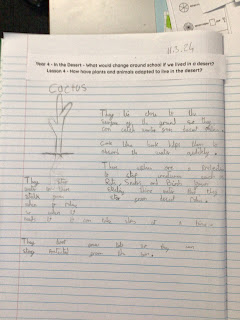This week, the children recapped the definition of a desert as well as understanding that not all deserts are hot. Then, they used their knowledge of the lines of latitudes: Tropic of Cancer, Equator and Tropic of Cancer. The children identified that the areas between the two lines of latitude is known as the Tropics. Here, the climate is hot and warm. There are not many clouds in the desert at night which means that the climate will be cold then. As we expect the climate to be warm there most of the deserts we looked at today are warm in the day. Following this the children used their atlases to locate different deserts in the world. An amazing lesson year 4, lots of dojos handed out today.





